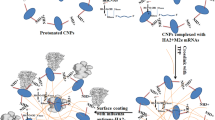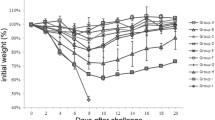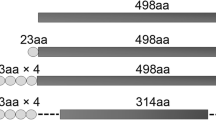Abstract
Influenza vaccines based on conserved antigens could provide cross-protection against infections by multiple subtypes of influenza A virus. Influenza matrix protein 2 (M2) is highly conserved in all influenza A strains. In this study, we deleted the transmembrane domain of the M2 of the avian influenza virus (AIV) A/Chicken/Jiangsu/7/2002 (H9N2) strain to create an M2 without a transmembrane domain, named sM2, which was efficiently expressed in Escherichia coli. The sM2 protein was administered intranasally to mice in combination with chitosan adjuvant three times at an interval of 3 weeks. Three weeks after the last immunization, the mice were challenged with a lethal dose (5 × LD50) of A/Chicken/Jiangsu/7/2002 (H9N2) virus, PR8 (H1N1) virus and A/Chicken/Henan/12/2004 (H5N1) virus. The protective immunity of the vaccine was evaluated by determining the survival rates, residual lung virus titers, body weight, and the serum antibody titers of the mice. Nasal administration of 15 μg sM2 in combination with chitosan completely protected mice against the homologous virus and protected 90 and 30% of the mice against the heterologous H1N1 and H5N1 viruses, respectively. The study indicated that the sM2 protein was a candidate antigen for a broad-spectrum influenza virus vaccine and that the adjuvant chitosan improved the efficacy of the sM2 vaccine.




Similar content being viewed by others
References
Cox NJ, Subbarao K (1999) Influenza. Lancet 354:1277–1282
De Filette M, Fiers W, Martens W et al (2006) Improved design and intranasal delivery of an M2e-based human influenza A vaccine. Vaccine 24:6597–6601
Palese P (2004) Influenza: old and new threats. Nat Med 10:S82–S87
Thompson WW, Shay DK, Weintraub E, Brammer L, Cox N, Anderson LJ, Fukuda K (2003) Mortality associated with influenza and respiratory syncytial virus in the United States. JAMA 289:179–186
Hilleman MR (2002) Realities and enigmas of human viral influenza: pathogenesis, epidemiology and control. Vaccine 20:3068–3087
Okuda K, Ihata A, Watabe S et al (2001) Protective immunity against influenza A virus induced by immunization with DNA$ plasmid containing influenza M gene. Vaccine 19:3681–3691
De Filette M, Ramne A, Birkett A et al (2006) The universal influenza vaccine M2e-HBc administered intranasally in combination with the adjuvant CTA1-DD provides complete protection. Vaccine 24:54451
Steinhauer DA, Skehel JJ (2002) Genetics of influenza viruses. Annu Rev Genet 36:305–332
Chen Q, Kuang H, Wang H et al (2009) Comparing the ability of a series of viral protein-expressing plasmid DNAs to protect against H5N1 influenza virus. Virus Genes 38:30–38
Reid AH, Fanning TG, Janczewski TA et al (2002) Characterization of the 1918 “Spanish” influenza virus matrix gene segment. J Virol 76:10717–10723
Fiers W, De Filette M, Birkett A et al (2004) A “universal” human influenza A vaccine. Virus Res 103:173–176
Zebedee SL, Lamb RA (1988) Influenza A virus M2 protein: monoclonal antibody restriction of virus growth and detection of M2 in virions. J Virol 62:2762–2772
Treanor JJ, Tierney EL, Zebedee SL et al (1990) Passively transferred monoclonal antibody to the M2 protein inhibits influenza A virus replication in mice. J Virol 64:1375–1377
Fan J, Liang X, Horton MS et al (2004) Preclinical study of influenza virus A M2 peptide conjugate vaccines in mice, ferrets, and rhesus monkeys. Vaccine 22:2993–3003
Slepushkin VA, Katz JM, Black RA et al (1995) Protection of mice against influenza A virus challenge by vaccination with baculovirus-expressed M2 protein. Vaccine 13:1399–1402
Frace AM, Klimov AI, Rowe T et al (1999) Modified M2 proteins produce heterotypic immunity against influenza A virus. Vaccine 17:2237–2244
Neirynck S, Deroo T, Saelens X et al (1999) A universal influenza A vaccine based on the extracellular domain of the M2 protein. Nat Med 5:1157–1163
Mozdzanowska K, Feng J, Eid M et al (2003) Induction of influenza type A virus-specific resistance by immunization of mice with a synthetic multiple antigenic peptide vaccine that contains ectodomains of matrix protein 2. Vaccine 21:2616–2626
Watabe S, Xin KQ, Ihata A et al (2001) Protection against influenza virus challenge by topical application of influenza DNA vaccine. Vaccine 19:4434–4444
Tompkins SM, Zhao ZS, Lo CY et al (2007) Matrix protein 2 vaccination and protection against influenza viruses, including subtype H5N1. Emerg Infect Dis 13:426–435
Brandtzaeg P (2003) Role of mucosal immunity in influenza. Dev Biol (Basel) 115:39–48
Zuercher AW, Coffin SE, Thurnheer MC et al (2002) Nasal-associated lymphoid tissue is a mucosal inductive site for virus-specific humoral and cellular immune responses. J Immunol 168:1796–1803
Russell MW, Moldoveanu Z, White PL et al (1996) Salivary, nasal, genital, and systemic antibody responses in monkeys immunized intranasally with a bacterial protein antigen and the Cholera toxin B subunit. Infect Immun 64:1272–1283
Muszkat M, Friedman G, Schein MH et al (2000) Local SIgA response following administration of a novel intranasal inactivated influenza virus vaccine in community residing elderly. Vaccine 18:1696–1699
Hirabayashi Y, Kurata H, Funato H et al (1990) Comparison of intranasal inoculation of influenza HA vaccine combined with cholera toxin B subunit with oral or parenteral vaccination. Vaccine 8:243–248
Garmise RJ, Mar K, Crowder TM et al (2006) Formulation of a dry powder influenza vaccine for nasal delivery. AAPS PharmSciTech 7:E19
Bergquist C, Johansson EL, Lagergard T et al (1997) Intranasal vaccination of humans with recombinant cholera toxin B subunit induces systemic and local antibody responses in the upper respiratory tract and the vagina. Infect Immun 65:2676–2684
Xie Y, Zhou NJ, Gong YF et al (2007) Th immune response induced by H. pylori vaccine with chitosan as adjuvant and its relation to immune protection. World J Gastroenterol 13:1547–1553
Mutsch M, Zhou W, Rhodes P et al (2004) Use of the inactivated intranasal influenza vaccine and the risk of Bell’s palsy in Switzerland. N Engl J Med 350:896–903
van Ginkel FW, Jackson RJ, Yuki Y et al (2000) Cutting edge: the mucosal adjuvant cholera toxin redirects vaccine proteins into olfactory tissues. J Immunol 165:4778–4782
Synowiecki J, Al-Khateeb NA (2003) Production, properties, and some new applications of chitin and its derivatives. Crit Rev Food Sci Nutr 43:145–171
Bacon A, Makin J, Sizer PJ et al (2000) Carbohydrate biopolymers enhance antibody responses to mucosally delivered vaccine antigens. Infect Immun 68:5764–5770
Jabbal-Gill I, Fisher AN, Rappuoli R et al (1998) Stimulation of mucosal and systemic antibody responses against Bordetella pertussis filamentous haemagglutinin and recombinant pertussis toxin after nasal administration with chitosan in mice. Vaccine 16:2039–2046
McNeela EA, O’Connor D, Jabbal-Gill I et al (2000) A mucosal vaccine against diphtheria: formulation of cross reacting material (CRM(197)) of diphtheria toxin with chitosan enhances local and systemic antibody and Th2 responses following nasal delivery. Vaccine 19:1188–1198
Westerink MA, Smithson SL, Srivastava N et al (2001) ProJuvant (Pluronic F127/chitosan) enhances the immune response to intranasally administered tetanus toxoid. Vaccine 20:711–723
Read RC, Naylor SC, Potter CW et al (2005) Effective nasal influenza vaccine delivery using chitosan. Vaccine 23:4367–4374
Illum L (1998) Chitosan and its use as a pharmaceutical excipient. Pharm Res 15:1326–1331
Singla AK, Chawla M (2001) Chitosan: some pharmaceutical and biological aspects—an update. J Pharm Pharmacol 53:1047–1067
Wedmore I, McManus JG, Pusateri AE et al (2006) A special report on the chitosan-based hemostatic dressing: experience in current combat operations. J Trauma 60:655–658
Zaharoff DA, Rogers CJ, Hance KW et al (2007) Chitosan solution enhances both humoral and cell-mediated immune responses to subcutaneous vaccination. Vaccine 25:2085–2094
Qiu M, Fang F, Chen Y et al (2006) Protection against avian influenza H9N2 virus challenge by immunization with hemagglutinin- or neuraminidase-expressing DNA in BALB/c mice. Biochem Biophys Res Commun 343:1124–1131
Yetter RA, Lehrer S, Ramphal R et al (1980) Outcome of influenza infection: effect of site of initial infection and heterotypic immunity. Infect Immun 29:654–662
Tamura S, Ito Y, Asanuma H et al (1992) Cross-protection against influenza virus infection afforded by trivalent inactivated vaccines inoculated intranasally with cholera toxin B subunit. J Immunol 149:981–988
Chen Z, Sahashi Y, Matsuo K et al (1998) Comparison of the ability of viral protein-expressing plasmid DNAs to protect against influenza. Vaccine 16:1544–1549
Chen J, Fang F, Li X et al (2005) Protection against influenza virus infection in BALB/c mice immunized with a single dose of neuraminidase-expressing DNAs by electroporation. Vaccine 23:4322–4328
Liu W, Zou P, Chen YH (2004) Monoclonal antibodies recognizing EVETPIRN epitope of influenza A virus M2 protein could protect mice from lethal influenza A virus challenge. Immunol Lett 93:131–136
Chen J, Zhang F, Fang F et al (2007) Vaccination with hemagglutinin or neuraminidase DNA protects BALB/c mice against influenza virus infection in presence of maternal antibody. BMC Infect Dis 7:118
Zhang F, Chen J, Fang F et al (2005) Maternal immunization with both hemagglutinin- and neuraminidase-expressing DNAs provides an enhanced protection against a lethal influenza virus challenge in infant and adult mice. DNA Cell Biol 24:758–765
Illum L, Jabbal-Gill I, Hinchcliffe M et al (2001) Chitosan as a novel nasal delivery system for vaccines. Adv Drug Deliv Rev 51:81–96
Zhu B, Qie Y, Wang J et al (2007) Chitosan microspheres enhance the immunogenicity of an Ag85B-based fusion protein containing multiple T-cell epitopes of Mycobacterium tuberculosis. Eur J Pharm Biopharm 66:318–326
Acknowledgments
This study was supported by the following research funds: the European Union project (SP5B-CT-2006-044161); the National 973 Project (2005CB523007, 2006CB933102); the Chinese Academy of Sciences (KSCX1-YW-R-14); the National Key Technology R&D Program of China (2006BAD06A03).
Author information
Authors and Affiliations
Corresponding author
Rights and permissions
About this article
Cite this article
Sui, Z., Chen, Q., Wu, R. et al. Cross-protection against influenza virus infection by intranasal administration of M2-based vaccine with chitosan as an adjuvant. Arch Virol 155, 535–544 (2010). https://doi.org/10.1007/s00705-010-0621-4
Received:
Accepted:
Published:
Issue Date:
DOI: https://doi.org/10.1007/s00705-010-0621-4




